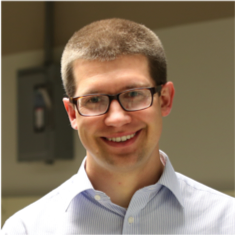CaSTL Seminar Series with L. Robert Baker
Directly observing electron dynamics at surfaces is required to reveal the material properties that determine efficiency during energy conversion catalysis. Toward this goal, we have developed a tabletop instrument for femtosecond X-ray spectroscopy of surfaces. This method combines the benefits of X-ray absorption, such as element, oxidation, and spin state specificity, with surface sensitivity and ultrafast time resolution, having a probe depth of only a few nm and time resolution faster than 100 fs. Using this technique, we study the electron dynamics in a number of catalytically relevant metal oxides. Specifically, Fe2O3 is an earth-abundant semiconductor with a band gap ideally suited for solar light harvesting, but its catalytic performance is low due to surface electron trapping. In these studies, we show that surface trapping occurs in less than 1 ps. Surprisingly this process is not sensitive to Fe2O3 surface morphology, indicating that electron trapping is not influenced by surface defects. Instead, ultrafast trapping occurs by the interactions of the free electrons with the lattice nuclei via a process known as small polaron formation. In contrast to Fe2O3, CuFeO2 is a closely related earth-abundant photocatalyst, which can reduce CO2 using sunlight. Specifically, we have recently shown that CuFeO2 is a selective catalyst for photo-electrochemical CO2 reduction to acetate. However, the role of electronic structure and charge carrier dynamics in this process has not been well understood. Using ultrafast X-ray spectroscopy, it is possible to track electrons and holes independently in the Fe 3d, Cu 3d, and O 2p states comprising the band structure of this photocatalyst. Results show that photocatalytic activity is related to ultrafast hole relaxation leading to spatial charge separation in the layered CuFeO2 lattice, which cannot occur in Fe2O3. This ability to elucidate site-specific charge carrier dynamics in real time provides important criteria for the rational design of catalysts for efficient solar energy harvesting based on their underlying photophysics.
Bio:
L. Robert Baker received a BS degree from Brigham Young University in 2007 and a MS degree from Brigham Young University in 2008. He received his PhD from the University of California, Berkeley under the supervision of Gabor Somorjai in 2012. Following his PhD he performed postdoctoral research with Stephen Leone before joining The Ohio State University as an assistant professor in 2014. His research interests are in ultrafast spectroscopy, heterogenous catalysis, and surface science. He is a recipient of the Air Force Office of Scientific Research Young Investigator Award and the Department of Energy Early Career Award.



